Think French cooking is a little too chichi for the average home chef?
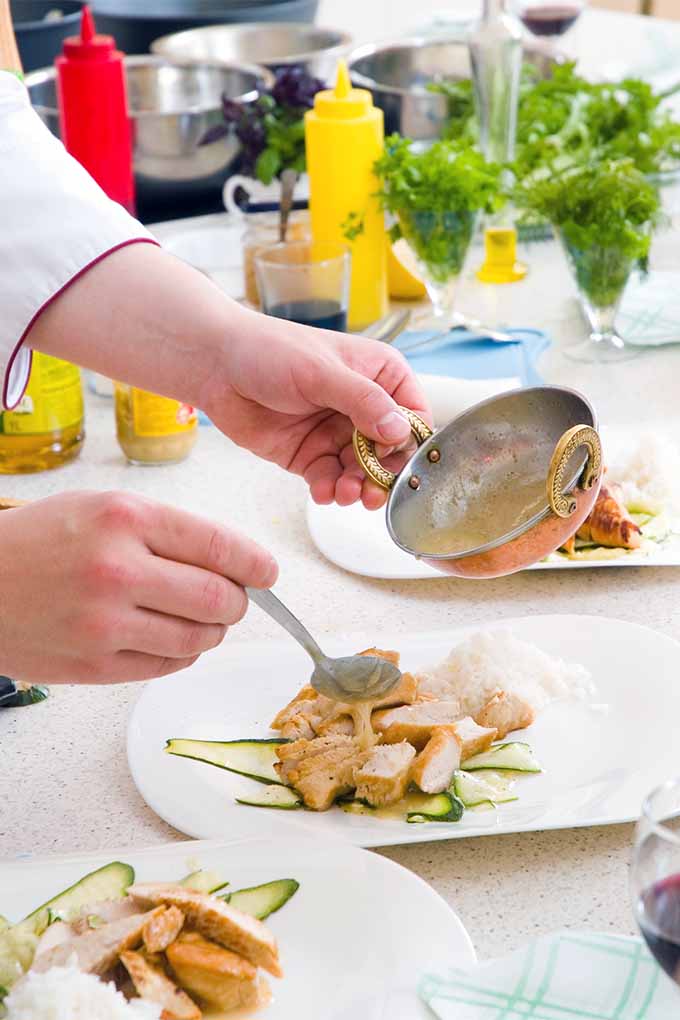
Well, you might want to think again. Learning a few basic French culinary techniques can help you to save time, prepare healthier meals, and take the enjoyment of cooking, and dining, to stratospheric levels!
For many, the idea of French cuisine is relegated to an exclusive realm, reserved for sophisticated chefs and fancy restaurants.
In truth, if you do any meal prep at home, you probably already use some of these methods. And if you’re a beginner, learning these basics is well worth the effort.
Whatever your skill level, this primer will help you to master some of the elementary steps that lead to organized meal preparation and easy, delicious meals.
French Cooking with Attitude
While French cuisine may seem complicated, it really involves a lot of common sense laid out in a logical procession of steps that have been proven over centuries of tradition.
Dishes are created by the harmonious building of flavors, layer by layer, to enhance a main ingredient. But the real key to understanding the broad application of French cooking is in the simplicity of logic.
Each technique has a purpose, and each purpose has an application. Braising, poaching, sautéing, and so on are specifically used in recipes because they produce the best results for the ingredients called for.
But, more than just the mechanics and logic, French cooking is also an attitude.
It’s about the enjoyment of planning a meal, then sharing it with family and friends (or your own splendid company) – it’s a celebration of food, with audience participation.
As opposed to the frazzled and frenzied meal preparation many of us experience on a daily basis, French cooking is an exercise in relaxation at day’s end, and appreciation for the simple blessings of food and family.

Oh, and don’t forget the wine!
Now, all of this isn’t to minimize the most extraordinary dishes master chefs of this sumptuous cuisine can create – but we’re not going after a Michelin star here.
What we want is a sound foundation of techniques that can be built upon. Because once a few of the basics are mastered, you can then add to your repertoire for fancier forays into la cuisine Française.
Like any good skillset, the art of French cooking is learned step by careful step, building confidence with practice.
And so, we present our glossary of 11 culinary terms from A to Z, with a couple of cutting techniques, some flavoring methods, a few basics on creating sauces, and some easy and delicious methods for preparing entrées.
11 Basic French Cooking Techniques
1. Bouquet Garni
A bouquet garni is, quite literally, a garnish bouquet.
A blend of herbs, it’s used to add flavor to savory dishes such as soups and stews, casseroles, and stocks. The bouquet is added to simmering dishes to garnish with flavor, then removed before serving.
Fresh herbs are used in the traditional bouquet, but dried ones work as well. And a dried version actually allows the addition of a few ingredients that aren’t easily tied, such as peppercorns or juniper berries.
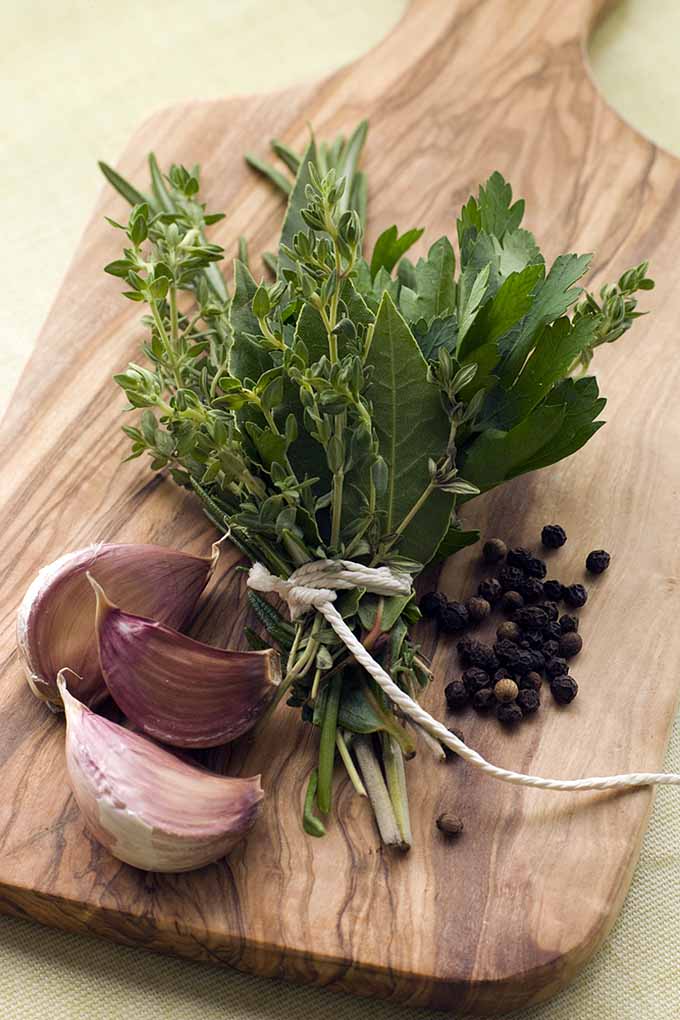
As such, there are two different methods of bundling them for the pot.
For fresh herbs, the classic combination is 3 sprigs of parsley, 2 sprigs of rosemary or thyme, and 1 bay leaf – with long stems.
Using unwaxed kitchen twine, wrap the stems with the string, then tie off with a long loop tail. The tail makes it easier to retrieve the bouquet for disposal when the cooking time is finished.
For dried herbs, you’ll need a 12 x 12-inch piece of cheesecloth or muslin. Fold the cheesecloth in half, then in half again to make a small square.
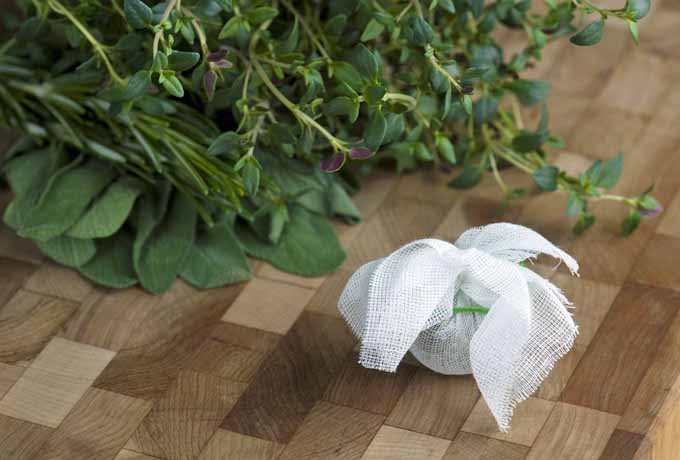
To the center of the square, add your dried herb blend. A good basic combination is 1 tablespoon parsley, 1 teaspoon thyme, 4-6 peppercorns, and 1 bay leaf.
Gather up the corners of the square and tie with kitchen twine into a sachet, again leaving a long tail to easily retrieve from the pot.
Of course, the herbs can be switched to suit any particular dish. Celery leaves, oregano, sage, savory, and tarragon all make flavorful contributions to any bouquet.
2. Chiffonade
A chiffonade cut is used to shred or finely chop flat leafy vegetables and herbs like spinach, basil, or lettuce, into very fine ribbons.
This technique is used on fresh ingredients to cut thin, uniform strips that will evenly distribute flavor, and adds a pretty, lacy appearance.
There are two basic techniques to chiffonade, depending on the ingredients being chopped.
In the first method, leaves are stacked on top of each other, then folded or rolled tightly, and cut perpendicular to the roll with a back slice. This is the preferred method for leaves that don’t have a tough center stem.
For leaves that do have a thick center stem, make a small stack of leaves and secure one edge with your fingertips. Starting on the opposing edge, slice finely until the stem is reached, then spin the stack and repeat until you reach the stem again, which can then be discarded.
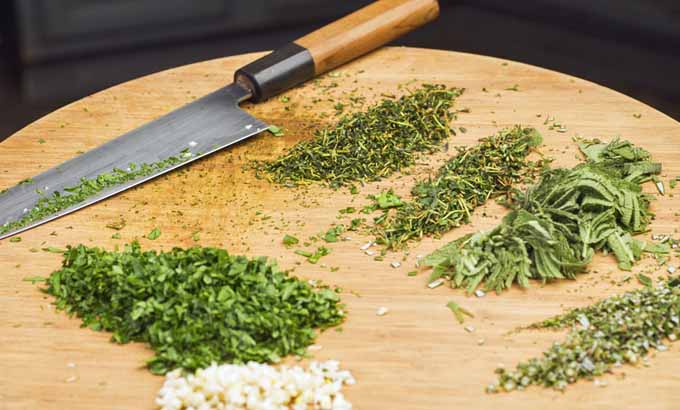
To create the very fine slices of a chiffonade cut, the back slice is the best cutting stroke.
At a low angle, place the front edge of your knife on the cutting board just above your leaf stack. Using a claw grip on the stack, lightly rest the flat of the blade against your knuckles.
Slowly draw the blade back until the tip slices through the ingredients, then push forward again to the starting point. Repeat with narrow strokes until finished.
The key to the back slice is to keep the knife point on the cutting surface, and use the same motion as for a hand saw – there’s very little up and down movement, just a bit of wrist action to push and pull the knife.
Et voilà! When finished, you’ll have a lovely pile of chiffonade ribbons!
3. Coulis
A coulis is a colorful sauce that’s smooth and thick, usually made from one primary ingredient, like raspberries.
After preparation, it’s drizzled on desserts, used as a condiment with savory dishes, and sometimes added to give an additional flavor burst to sauces – and it will often adorn a serving dish like a string of jewels.
Made from fruits, vegetables, or herbs, ingredients are cooked, puréed, and sieved before serving.
There’s really no limit to what ingredients can be used – fresh berries, apricots, plums, roasted bell peppers, hot peppers, lavender, and mint are all fair game.
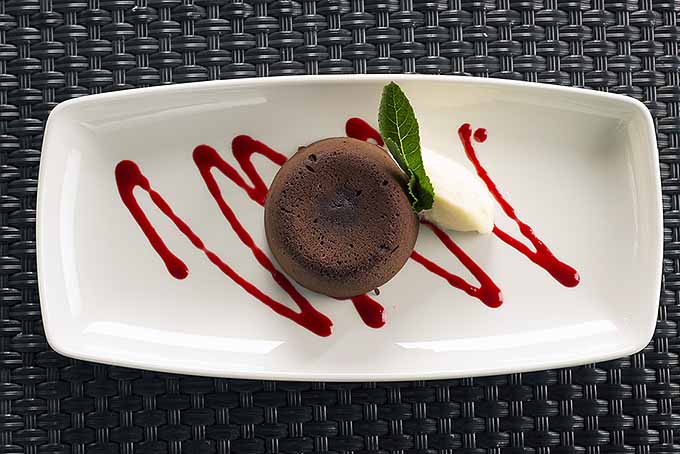
Simple to prepare, ingredients are simmered with a bit of water for five minutes or so. After cooling for a few minutes, everything goes into a blender to be puréed, then strained through a fine mesh sieve or chinois.
Once prepared, it can be poured or spooned over the top of your dish.
A coulis can be served warm or cold, will keep in the fridge for three days, and can be frozen for up to three months.
Berry and fruit coulis usually have some sugar added in cooking, and perhaps a drop of vanilla or almond extract.
And vegetable coulis will often have added flavor intensives, such as herbs, seasonings, or spices.
Delightful as a finishing touch, coulis not only adds color and flavor to a dish, but a dash of panache as well!
4. Déglacer
Déglacer is a method of deglazing or loosening the deposits of browned juices and fats, known as the fond, that accumulate on the bottom of a pan during cooking.
A small amount of liquid, such as water, stock, or wine, is added to the pan and then brought to a low boil. As it simmers, the bottom is gently scraped and then stirred to dissolve the fond.

The fond has incredible concentrated flavors, and once dissolved, the liquid is used as the basis for a flavorful pan sauce, or reduced to a demi-glace to accompany the main course.
If you want to gain a little more confidence with this technique, learn more about properly cooking with wine and check out our full guide on deglazing a pan.
5. Demi-Glace
A demi-glace, or demi glaze, is made by reducing a stock down to a thick, concentrated form.
The traditional demi-glace is made of veal stock and espagnole sauce, which is then simmered for hours until it’s reduced by half. The result is a thick, rich sauce with intense flavors.
Did You Know?
Espagnole sauce is one of the five “mother” sauces that form the foundation of French sauce making – it’s a brown sauce made of brown roux, mirepoix, and tomato puree.
If you have the time and inclination, learning how to make a true demi-glace is a rewarding exercise – but it’s also quite labor intensive and time consuming.
For those that don’t have the luxury of spending a day in the kitchen to make an authentic demi-glace, there are shortcuts that produce very acceptable results – the semi-demi-glace, to coin a term a la Julia Child!
For shortcut demi-glace, bring 2 quarts of beef stock mixed with 2 tablespoons red wine to a boil, then lower the heat and simmer for several hours until reduced to about 2 cups.
When it coats and sticks to the back of a spoon, you have the right consistency.
This method also takes considerable time to actually reduce. But if you have some homemade stock in the freezer or a good store-bought beef consommé, it’s much less work.
And once you’ve turned it down to a simmer, your time is free for other tasks.
6. En Papillote
For moist, delicious foods accompanied by divine aromas, learning to prepare dishes en papillote is a must.
Cooking en papillote means to bake food in a packet, or parcel, of parchment paper, which essentially cooks ingredients by steam.
In a nutshell, the process is to place food in the center of a piece of parchment paper, then turn the edges a couple of times to seal the contents.
As the internal temperature rises, steam forms from the natural juices and any additional liquids, which then circulates back into the food.

This helps to cook foods quickly and keeps the contents delectably moist. And when the packet is opened, the most wonderful, mouth-watering fragrance is released.
Other cultures have long used this simple and elegant cooking method as well, using natural wrappers like banana and lotus leaves or corn husks to enclose foods and steam the contents.
This is also a very pragmatic method for home chefs, as it’s a fast and simple way to prepare one-pot meals in individual packets.
And healthy too, as only a drop or two of oil or other liquids is required for flavor and steam. Plus, cleanup is easy – just toss the paper when you’re finished.
We have the details for creating a papillote envelope in this fish preparation article, but it works equally well for boneless cuts of meat and poultry.
7. Julienne
A julienne cut is another knife skill that’s used to prepare foods, usually vegetables, into small, uniform rectangles that look like matchsticks, and is used primarily for presentation purposes.
But having said that, it’s also used on proteins in stir fries, as the small pieces will fry as quickly as equally sized vegetables.
To julienne vegetables, peel if necessary, then trim the root and stem ends.
For rounded vegetables, such as carrots or zucchini, cut in half lengthwise and lay the flat side on the cutting board to stabilize, then trim the remaining three sides until you have a flat, four-sided block.
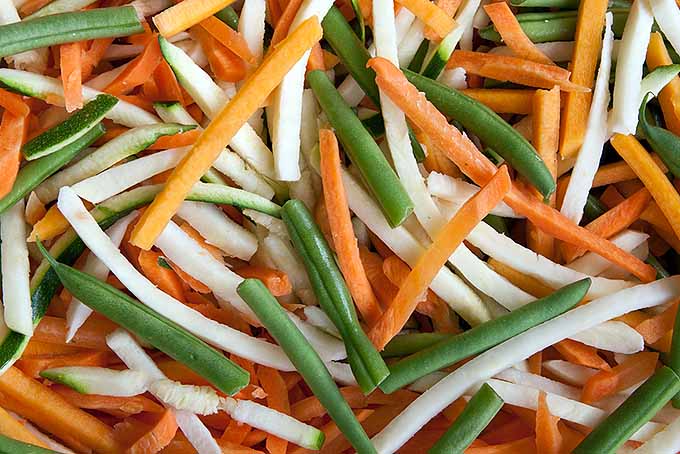
Now cut the block into two-inch sections. This is a standard length for julienned veggies, but they can be any length. Just remember, anything longer than a bite-sized two inches will be harder to eat.
Next, slice the rectangle into 1/8-inch slats, then stack a few slats on top of each other – but not too many.
The higher the stack, the more likely it will be to slip and you’ll end up with triangles instead of rectangles.
Now slice the slats again into 1/8-inch matchsticks.
The cutting motion used to julienne is the slicing technique, which utilizes the sweet spot on the cutting edge of a chef’s knife, about 3 inches in from the heel.
Use a claw grip to hold the ingredients, and begin by placing the cutting edge of the knife tip on your cutting board, holding the rest of the blade above the food.
Allow the blade to drop straight down through the ingredients until it contacts the cutting surface. As contact is made, push forward to slice cleanly with the sweet spot.
Lift the tip to reposition for the next cut and repeat the drop and push motion.
If you need to create a lot of julienned veggies in one go, a mandoline with a julienne blade can be a lifesaver.
8. Mirepoix
A mirepoix is a mixture of braising or simmering vegetables, usually onion, celery, and carrots.
A trio of flavorful vegetables is used as an important base in many cuisines around the globe. These include the Spanish or Italian combination of garlic, onion, and tomato, or the Chinese trio of scallions, ginger, and garlic.
Perhaps the most commonly thought of blend alongside the French version is the Creole take on mirepoix, which partners onion and celery with bell pepper. This combination has been dubbed the “Holy Trinity” in areas with strong Catholic influence, particularly in Louisiana, where it may have originated.
All of these impart heavenly flavors to meat, fish, poultry, stocks, soups, stews, and casseroles.
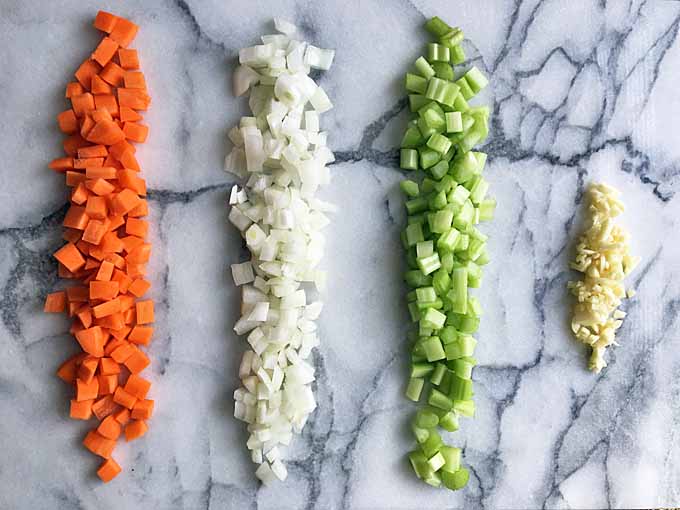
Vegetables are roughly chopped, typically in a ratio of 2:1:1 – 2 parts onion, 1 part celery, and 1 part carrot – and are often mixed with seasonings and herbs.
The size of the cut depends on the cooking time, and how the mirepoix is to be used.
For example, as a bed for a pan-cooked fish, a small dice of 1/8 or 1/4 inches would be appropriate, to cook quickly and release aromas in concert with the short processing time for fish.
For a soup or stew that requires an hour or two on the stove, chunkier pieces of 1/2 or 3/4 inches are a better time match, and will add extra body.
And for a long-simmering pot of stock, quartered or halved vegetables are appropriate to slowly release flavors.
9. Mise en Place
In cooking terms, mise en place means “to put in place.” It also means “to establish or introduce.” Both are appropriate translations, as mise en place is all about setting up your ingredients, and the establishment of sound preparation practices.
At first glance, it can seem a bit fussy. But learning the lesson of mise en place actually saves time in the long run, and makes for more efficient kitchen practices.
It’s an exercise in organization that allows you to focus on cooking instead of scrambling to find ingredients, utensils, or pans.
It begins with reading a recipe from start to finish. Not skimming through a recipe, but actually reading it.
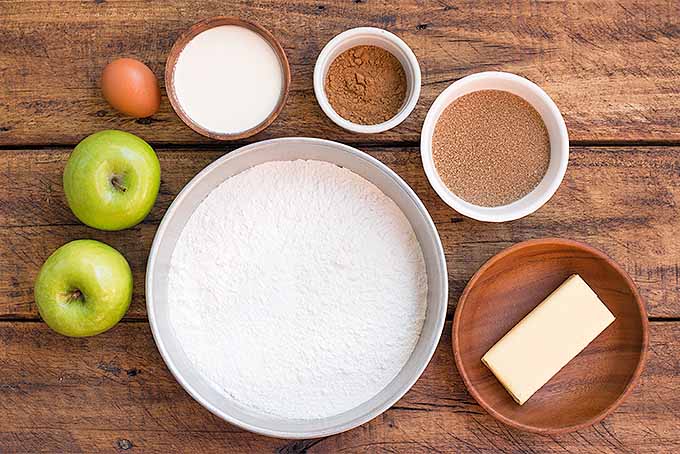
After reading, you’ll know what ingredients and tools are needed, and whether you can start to prep, or need to shop.
Start at the start, and work through the recipe. As it calls for ingredients and actions, lay everything out on the counter or stove in order of appearance, and prepare as directed.
Vegetables and herbs are washed and chopped. Spices and seasonings are portioned. Fish is deboned, meat tenderized.
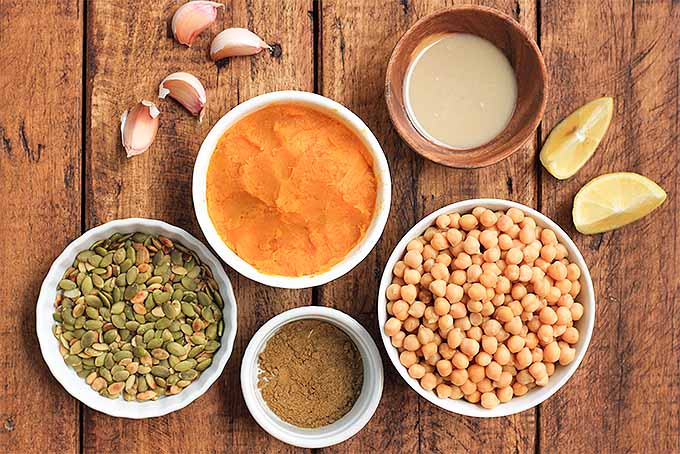
Cans are opened and pans greased. And only after all of the prep work is complete should cooking begin.
With everything in its place, the entire cooking session becomes one fluid motion – mistakes are virtually eliminated and there’s no hectic searching to find what you need.
Mise en place truly makes cooking more enjoyable – it becomes an experience of joie de vivre (exhilaration) instead of sacre bleu (damn it)!
10. Roux
A roux is one of the rudimentary thickening agents in culinary preparation, and it’s the foundation of the common white sauce known as bechamel.
Used mainly for thickening sauces, gravies, and soups, a roux is made of equal parts (by weight) of fat and flour.
The flour is whisked into a hot fat, then cooked to remove the raw flour taste.

Traditionally, the fat used is clarified butter, due to its ability to withstand a higher temperature without browning. But whole butter works fine as well.
Rendered bacon fat adds a lovely flavor to a roux, as do pan drippings when making gravy.
Vegetable oils can be used, but the flavor won’t be as rich – and a roux made with vegetable oil does tend to separate as it cools.
A roux can be white, blond, or brown with the main difference being the amount of time it’s cooked, which is determined by the dish it will be used in.
Visit this article on thickening agents for detailed steps on how to create a roux.
11. Sauté
To sauté is to lightly fry foods quickly in a small amount of hot fat or oil at high heat while the chef shakes the pan, making the ingredients jump – which prevents sticking and ensures even cooking.
Sauté is also a ballet term for a jump straight up in the air, where the dancer lands in the same position as when they started – you can see the connection to what happens in cooking.
A simple process, to sauté effectively, ingredients need to be moved about constantly as they cook, either by shaking the pan, flipping ingredients, or swirling and tossing.
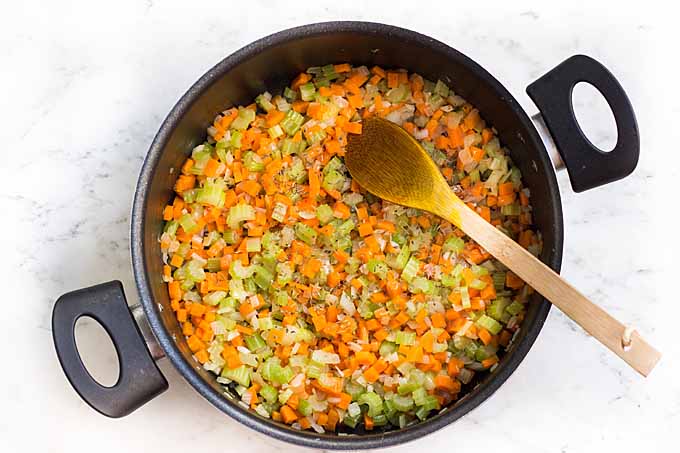
This is why a sturdy sauté pan, with a wide bottom and straight sides, is the ideal pan for the job.
With all the shaking, tossing, and flipping required, ingredients stay in the pan and don’t slosh over the edges, as will happen with a skillet or frying pan. And the wide bottom also ensures even browning of all ingredients.
Once the ingredients have finished processing, deglaze the pan with a splash of water, stock, apple juice, or wine for a tasty, light sauce to top off your dish.
Sautéing veggies with a protein makes for a light, tasty meal and is ideal for weeknights, or any time your schedule is tight.
But I particularly enjoy sauteing meat. Meat like chicken, beef, or pork can be perfectly seared on the outside while staying moist and juicy on the inside. You’ll see this technique in our rustic French recipe for poulet saute a la paysanne Provencale.
La Fini
That brings us to the end of our primer on French cooking techniques.
This list is by no means comprehensive, but with each method practiced and mastered, another solid block is laid in your cooking foundation, expanding your recipe base and menu selection.
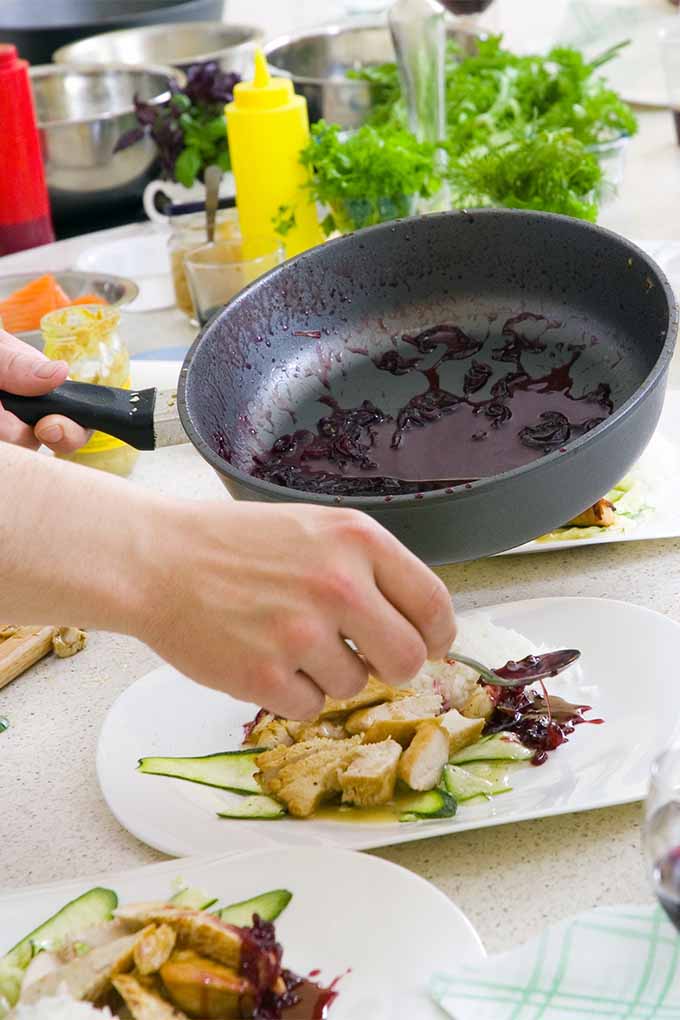
These methods have been honed and refined by French chefs for centuries – so why not learn a few tried and true practices that work, and save you time?
With just a few of these rudimentary techniques in place, you can begin to create delicious meals every night of the week!
How about you readers – do you have any favorite French cooking practices that make meals fun and easy? Let us know in the comments below!
Cooking technique photos by Mike Quinn, Felicia Lim, and Nikki Cervone, © Ask the Experts, LLC. ALL RIGHTS RESERVED. See our TOS for more details. Uncredited photos: Shutterstock.
About Lorna Kring
Recently retired as a costume specialist in the TV and film industry, Lorna now enjoys blogging on contemporary lifestyle themes. A bit daft about the garden, she’s particularly obsessed with organic tomatoes and herbs, and delights in breaking bread with family and friends.

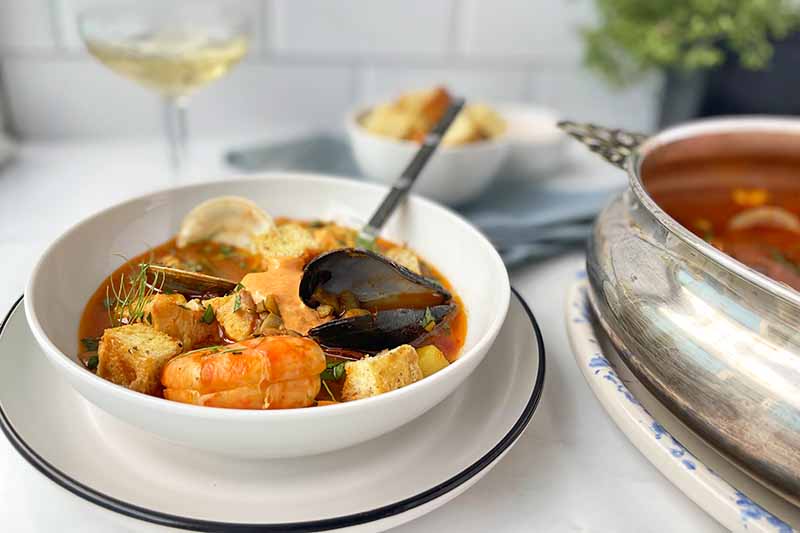

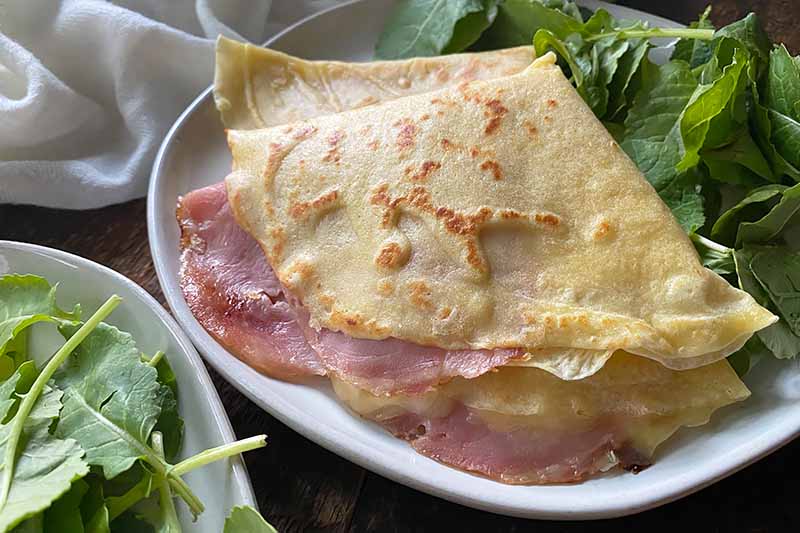
Wow. Thanks for posting this. French cuisine seems so difficult. There’re so many ingredients and anything can go wrong. I think that’s why people often prefer to cook italian stuff. I like going to French restaurants. They always pay attention to details and I can’t cook like that.
Glad you like the post Marley. It might seem difficult, but really, it’s a cuisine that just requires a bit of practice.
I need lesson cooking
Check out more of the articles in our Knowledge category for tutorials, tips, and tricks! You can find it here.